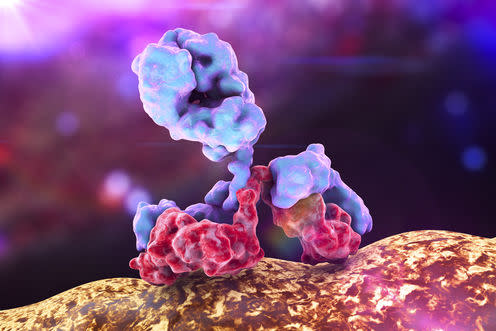The antibodies that were invented to help immunologists find GOD

In the classic 1966 science fiction film, Fantastic Voyage, a submarine is shrunk to microscopic size and injected into the blood stream of a scientist to remove a blood clot in his brain. The film illustrates many aspects of biology, perhaps most memorably when Raquel Welch ventures out of the submarine and is attacked by antibody molecules, which recognise her as a foreign invader and try to destroy her.
The antibodies of the film look like wriggly bits of string that rush at her and then adapt themselves to the shape of her body. For an immunologist Fantastic Voyage is interesting as it was made when there were competing theories of how antibodies worked.
One, the instructional theory, suggested that all antibody molecules were the same, but they folded themselves around their target and learned its shape – to forestall future invasions – before destroying it. The alternative – clonal selection theory – says that there were billions of different antibodies, each with a different shape. Each B cell (a type of immune cell) specialises in making just one type of antibody. When a foreign invader, such as bacteria, enters the body, only one B cell will recognise it. That B cell would begin to rapidly divide, making large numbers of clones. These newly cloned B cells secrete large amounts of antibody which stick to the invader and mark it for destruction.
The instructional theory was championed by no less a person than two-time Nobel Prize winner Linus Pauling, while Macfarlane Burnet (also a Nobel Prize winner) was the key proponent of clonal selection. The makers of the film followed Pauling, though, whether this was for scientific reasons or because the interaction between stringy antibodies and Welch made for better cinema isn’t clear. However, they were wrong, clonal selection theory won the argument.
Nowadays clonal selection seems so obviously right that it is difficult to remember that it initially appeared to have a fatal flaw. Scientists knew that the immune system of an animal could make antibodies to any foreign antigen. In the 1930s Karl Landsteiner showed that antibodies could be made to chemicals that never even existed naturally.
This led to a problem: for the clonal theory to be correct, there had to be pre-existing antibodies in animals or humans capable of recognising any antigen that might ever exist. This would require billions of different antibodies. And as every antibody is encoded by a separate gene, for there to be billions of antibody molecules there would also have to be billions of different genes. But there are no more than 25,000 genes to encode for everything in the human body, considerably fewer than needed to make the clonal selection theory possible.
The GOD problem
In the 1960s and 70s immunologists were increasingly convinced by the clonal selection theory. This led to a race to discover the solution to the problem of how so many different antibodies could be encoded. It was termed the “generation of diversity”, or GOD problem. The GOD problem was such an important and intriguing question that it attracted many of the best scientists of the decade, and resulted in several Nobel Prizes. Scientists showed that GOD was due to several biological mechanisms that people had not realised could happen, including rearrangement of chunks of DNA in chromosomes, and deliberate mutation of DNA sequences.
The difficulty and novelty of the science meant that immunologists had to develop new technologies. And some of these techniques, which were used to answer fundamental questions, ended up having practical applications. Perhaps most notably César Milstein was interested in understanding how, during an immune response, antibodies improve and become better at binding to their antigens. He wanted to immunise an animal and then, at various times, isolate B cells to make antibodies. He could then use these to study how well they bound to their antigen, and also sequence the gene encoding the antibody to see how it changed over time. In doing so he developed, together with Georges Köhler in 1975, a method that made B cells live forever, making limitless amounts of what they called a monoclonal antibody.
Milstein realised that their technique, called hybridoma technology, had much wider applications in science and medicine. The impact of monoclonal antibodies as scientific tools and for the treatment of diseases has been immense. Because they can be made in large amounts, and are specific, they are used in many experiments and clinical tests. They have now also become an important type of drug, having an important role to play in treating many cancers as well as other diseases such as rheumatoid arthritis. In economic terms, monoclonal antibody therapies are estimated to have had sales of US$75 billion in 2013.
In an age that demands that science is useful and should be applied, it is perhaps worth remembering that one of the most important technologies in medicine and biology was developed to answer a very basic scientific question. Scientists are motivated to develop new techniques to answer important questions. They often later find that these techniques have important practical applications beyond their original purpose. Applications that could save millions of lives.
This article was originally published on The Conversation. Read the original article.

Andrew George has over the years received academic grants from a variety of charities, industry and government sources to work on the development of antibody therapy.

 Yahoo News
Yahoo News 